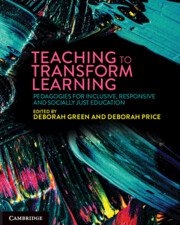Book contents
- Teaching to Transform Learning
- Acknowledgement of Country
- Teaching to Transform Learning
- Copyright page
- Contents
- Contributors
- Acknowledgements
- Introduction Understanding the learner to inform educators’ implementation of pedagogical approaches to transform learning
- Part 1 Pedagogies for all
- Part 2 Engaging pedagogies: making the curriculum come alive for all learners
- 8 Redesigning pedagogy for transformation: creative body-based learning
- 9 Building transformative classrooms through visual and creative body-based learning design
- 10 Co-constructed early childhood pedagogies
- 11 Strengths-based, learner-centred pedagogies: the voice of learners in co-creation and co-design
- 12 Pedagogy informed by community expertise
- 13 Nature-based approaches enhancing experiential learning
- 14 Beyond the four walls
- Part 3 Empowering pedagogies: 21st-century skill development and 22nd-century futures thinking
- Index
- References
8 - Redesigning pedagogy for transformation: creative body-based learning
from Part 2 - Engaging pedagogies: making the curriculum come alive for all learners
Published online by Cambridge University Press: 25 October 2024
- Teaching to Transform Learning
- Acknowledgement of Country
- Teaching to Transform Learning
- Copyright page
- Contents
- Contributors
- Acknowledgements
- Introduction Understanding the learner to inform educators’ implementation of pedagogical approaches to transform learning
- Part 1 Pedagogies for all
- Part 2 Engaging pedagogies: making the curriculum come alive for all learners
- 8 Redesigning pedagogy for transformation: creative body-based learning
- 9 Building transformative classrooms through visual and creative body-based learning design
- 10 Co-constructed early childhood pedagogies
- 11 Strengths-based, learner-centred pedagogies: the voice of learners in co-creation and co-design
- 12 Pedagogy informed by community expertise
- 13 Nature-based approaches enhancing experiential learning
- 14 Beyond the four walls
- Part 3 Empowering pedagogies: 21st-century skill development and 22nd-century futures thinking
- Index
- References
Summary
This chapter outlines creative and body-based learning (CBL) as a pedagogical approach that puts principles of transformative pedagogy into action. CBL provides a provocation to engage with the body and creativity as instruments for learning and modes of representation. In highlighting the liberatory impact for both learners and educators, we explore how such approaches disrupt power imbalances and allow young people agency, higher-order thinking and a sense of belonging to a community of learners. In developing a theoretical base for our work, we are drawn to theories of embodiment, arts and affect.
Keywords
- Type
- Chapter
- Information
- Teaching to Transform LearningPedagogies for Inclusive, Responsive and Socially Just Education, pp. 122 - 136Publisher: Cambridge University PressPrint publication year: 2024

